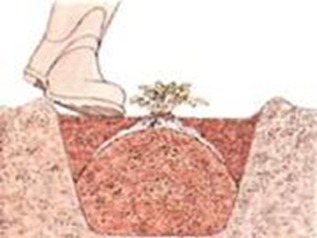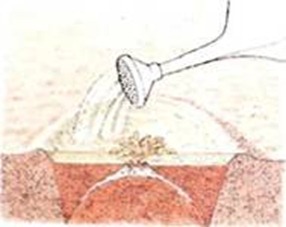





Three major items for this fortnight. First we plant the petunia, shown in the flower of the fortnight. Then we start on the herbaceous/perennial border. We’ll plant a rootclump of Korean chrysanthemum. Then we add a Mexican beauty, the pom-pom dahlia Flower of the Fortnight, Stage 9. We plant tubers. They’re frost tender so need to be lifted before frosts, stored dry over winter and replanted next spring. And we take a first look at the lawn.
Needs list: 6 petunia transplants; 7 dahlia tubers; 5 chrysanthemum plants; 1 pkt lawn food; 1 pkt bone meal.
Time budget: 4 hours in 2 weeks Early June weather/soil June brings the longest days of the year to the northern hemisphere, and plants respond to this by growing rapidly. Clear, sunny skies and light breezes punctuated by devastating thunderstorms are typical. Storm water can pan your soil: mulch with peat or compost to keep workable.
Subtropical America is once again the native haunt of the flower of this fortnight – the petunia. Fantastically colourful flowers, with great, floppy trumpet-shaped blooms in almost every colour. Striped forms are probably the most effective: alternatively, plant clumps of white petunias among the coloured ones. Don’t bother growing them from seed – you’ve enough other things to do anyway. Let the nurseryman grow them; just buy the transplants from him. Two tips for success: dig some bonfire ash into the soil before you plant. And when you plant, take out a hole with a trowel big enough to get all the roots in easily. Then firm and water. Give full sun, never let them dry out. Watch for slugs and other bugs.

By now the vegetable waste in your compost bin should be showing signs of decomposition. After every 6 in. of vegetable waste you put in, add a 1 in. layer of soil. If you’re short of soil use moss peat, leaf-mould, farmyard manure, bonfire ash or- if you live out back of beyond – night soil. How do you know when you’ve laid down a 6 in. layer of waste?
Paint red stripes on the back of the bin, each stripe 1 in. thick, 6 in. apart. The compost should never be allowed to become too wet or too hot. Beat winter wet and heavy storms by putting heavy-gauge plastic sheeting over the top. On the other hand, never let the heap dry out. In dry, hot weather, sprinkle lightly with the hose on it. Keeping the temperature right can be a problem. Fanatics take the temperature of their compost. Your nose is just as good a guide. If the heap smells like ammonia it’s too hot: lift the waste with a fork to let air in to cool it. If it smells like a garbage dump it’s too cool. Add an activator: urine is free and effective. Never put plants that have been weed-killed in the bin.

Perennials are the most reliable source of colour in your garden. They will go on year after year giving you a wonderful show, getting bigger and better with the passing of time. It takes all sorts to make a garden, just as it takes all sorts to make a world. Buy your plants dormant from your garden centre. Leave them overnight in a bucket of water, still wrapped in their paper. Dawn next day, dig over the bed as recommended in Stage 2, picking out stones, roots; add moss peat and bone meal. Then dig an individual hole for each plant, a spade’s blade deep and a spade’s blade across. Scatter the soil on the bed. Then make a hill at the bottom of the hole. You want to plant the dahlia tuber with its top 4 in. below soil level, so make the hill with soilless growing mix, rounding it up till the tuber is at the right level. Level off hole with more soilless growing mix. Firm, leaving a saucer-shaped depression. Soak. Plant the chrysanthemums the same way, except that you will need to make the soilless growing mix hills higher, so that the sprouting tops of the chrysanthemums are above soil level. Spread the roots over the hill, in-fill with more soilless growing mix, firm, soak. Soak both lots of plants twice, then rake surplus soil from rim back over depression. Next lawns. A good lawn is essential to any garden: it shows oft the flowers like well-polished shoes show off a good suit.
Over the next weeks we’ll be giving you some ideas for changing your lawn from a patch of coarse grass or bare earth and weeds into a springy lawn to be proud of Begin by feeding and mowing your lawn regularly. It’ll start looking better in next to no time. Dig out small weeds like daisies with a daisy fork: larger weeds with a trowel, fill hole with soilless growing mix and firm really hard.
Two Hour Gardening Project: Stage 26 Climbing Plants and Pergolas
Two Hour Gardening Project: Stage 25 Getting To Know Your Garden
Two Hour Gardening Project: Stage 24 Propagation and Growing Herbs
Two Hour Gardening Project: Stage 23 Principles of Pruning
Two Hour Gardening Project: Stage 22 Rock Gardening
Two Hour Gardening Project: Stage 18 Choosing Shrubs for the Garden
Two Hour Gardening Project: Stage 17 Fan Trained Fruit Trees
Copyright © www.100flowers.win Botanic Garden All Rights Reserved